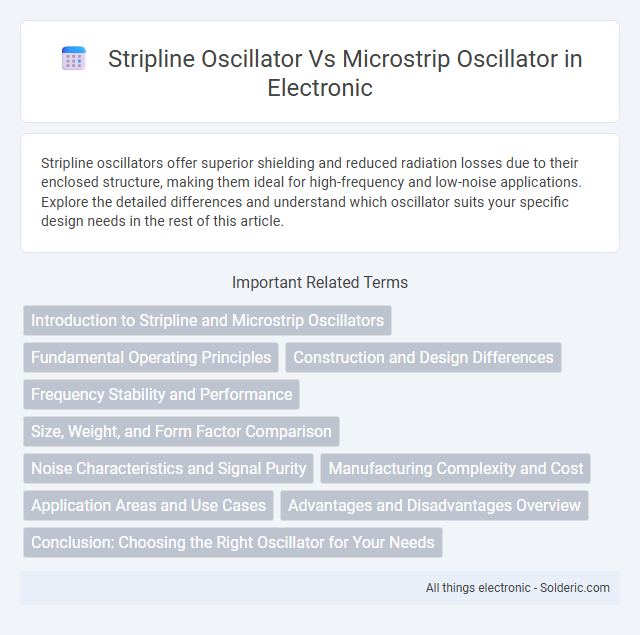Stripline oscillators offer superior shielding and reduced radiation losses due to their enclosed structure, making them ideal for high-frequency and low-noise applications. Explore the detailed differences and understand which oscillator suits your specific design needs in the rest of this article.
Comparison Table
| Feature | Stripline Oscillator | Microstrip Oscillator |
|---|---|---|
| Structure | Sandwiched conductor between two ground planes | Conductor on dielectric substrate with ground plane beneath |
| Manufacturing Complexity | Higher due to multilayer construction | Lower, simpler planar fabrication |
| Signal Loss | Lower, better shielding reduces radiation | Higher, more prone to radiation loss |
| Frequency Range | Typically used in microwave to millimeter-wave bands | Common in microwave and lower millimeter-wave bands |
| Q-Factor | Higher Q-factor due to reduced radiation | Lower Q-factor because of exposed line |
| Size | Bulkier, multilayer results in thicker design | Compact and lightweight |
| Applications | High-frequency stable oscillators, radar systems | Compact transceivers, portable devices |
Introduction to Stripline and Microstrip Oscillators
Stripline oscillators utilize a transmission line geometry with a conductor sandwiched between two ground planes, providing superior isolation and reduced radiation loss compared to microstrip configurations. Microstrip oscillators employ a conductor atop a dielectric substrate with a ground plane beneath, offering ease of fabrication and integration with planar circuits but with higher susceptibility to electromagnetic interference. Both oscillator types are integral in RF and microwave circuits, with stripline oscillators favored for high-quality factor resonators and microstrip oscillators preferred for compact, low-cost applications.
Fundamental Operating Principles
A Stripline oscillator operates using a transmission line structure where the signal propagates between two parallel conductors enclosed by ground planes, providing superior shielding and reduced radiation loss. In contrast, a Microstrip oscillator uses a conductor on one side of a dielectric substrate with a ground plane on the opposite side, enabling easier fabrication but higher radiation loss. Both types rely on feedback from their respective transmission lines to sustain oscillations, but the stripline's symmetric environment offers more stable impedance and frequency characteristics compared to the microstrip's open structure.
Construction and Design Differences
Stripline oscillators feature a signal conductor sandwiched between two ground planes, resulting in a controlled electromagnetic environment that minimizes radiation losses and ensures better isolation. Microstrip oscillators have a conductor trace on one side of a dielectric substrate with a ground plane on the opposite side, offering easier integration with planar circuits but increased radiation and dispersion effects. Your choice between stripline and microstrip oscillators depends on balancing performance requirements with fabrication complexity and substrate properties.
Frequency Stability and Performance
Stripline oscillators offer superior frequency stability due to their enclosed structure, which minimizes external electromagnetic interference and temperature variations. Microstrip oscillators provide higher performance in terms of ease of integration and manufacturability but are more susceptible to environmental changes that can affect frequency stability. Your choice depends on whether stable frequency output or ease of circuit integration is the priority for your application.
Size, Weight, and Form Factor Comparison
Stripline oscillators offer a more compact size and lighter weight due to their embedded conductor configuration, which confines electromagnetic fields within the substrate layers, resulting in reduced parasitic effects and improved signal integrity. Microstrip oscillators, with conductors on the substrate surface, tend to have a larger form factor and slightly higher weight, although they are easier to fabricate and integrate with surface-mounted components. The choice between the two depends on application requirements for miniaturization and performance stability in high-frequency circuits.
Noise Characteristics and Signal Purity
Stripline oscillators exhibit superior noise characteristics and signal purity compared to microstrip oscillators due to their enclosed structure, which minimizes electromagnetic interference and crosstalk. The stripline configuration offers better shielding and consistent dielectric properties, resulting in lower phase noise and cleaner output signals. Your choice of oscillator type should consider these factors for applications demanding high signal integrity and minimal noise.
Manufacturing Complexity and Cost
Stripline oscillators exhibit higher manufacturing complexity due to their multilayer PCB structure requiring precise alignment and additional dielectric materials, leading to increased fabrication costs. Microstrip oscillators benefit from a simpler single-layer design, which reduces production time and material expenses, making them more cost-effective for mass production. The choice between the two often balances the stripline's superior signal isolation against the microstrip's manufacturing efficiency and budget constraints.
Application Areas and Use Cases
Stripline oscillators are widely used in high-frequency radar and satellite communication systems due to their superior shielding and low interference characteristics, making them ideal for aerospace and defense applications. Microstrip oscillators find extensive use in consumer electronics, wireless communication devices, and automotive radar systems because of their cost-effective fabrication and ease of integration with planar circuits. Both oscillator types serve critical roles in RF and microwave circuits, with stripline oscillators favored for high-precision and high-stability requirements, while microstrip oscillators excel in compact, mass-produced applications.
Advantages and Disadvantages Overview
Stripline oscillators offer superior isolation and reduced radiation loss due to their fully enclosed structure, enhancing frequency stability and minimizing interference in high-frequency circuits. Microstrip oscillators provide simpler fabrication and easier integration with planar circuits but suffer from higher radiation losses and increased susceptibility to external noise. Your choice depends on balancing the need for performance stability in sensitive environments versus the benefits of cost-effectiveness and design simplicity.
Conclusion: Choosing the Right Oscillator for Your Needs
Stripline oscillators excel in high-frequency stability and reduced electromagnetic interference, making them ideal for precision applications requiring low phase noise and superior signal purity. Microstrip oscillators offer compact size, ease of integration, and cost-effectiveness, suitable for moderately stable frequency sources in portable or space-constrained devices. Selecting the right oscillator depends on balancing performance requirements with design constraints such as size, cost, and electromagnetic compatibility.
Stripline oscillator vs Microstrip oscillator Infographic

 solderic.com
solderic.com